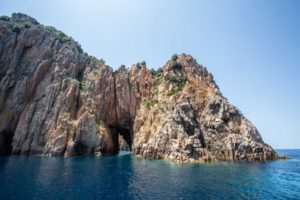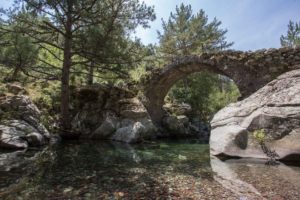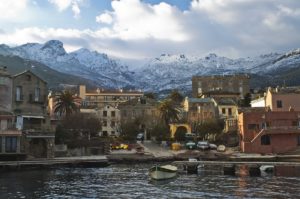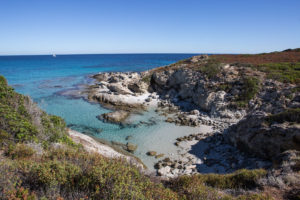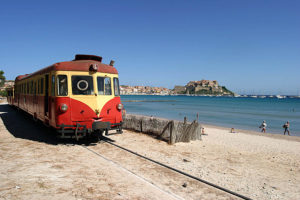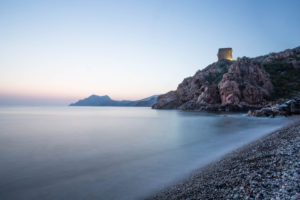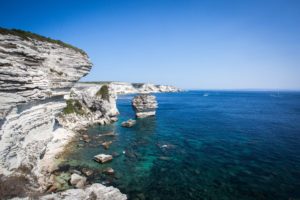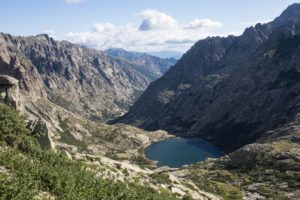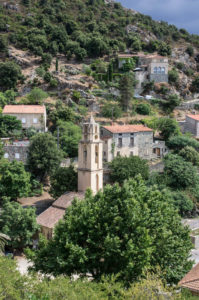Pour la version française, c’est par ici.
Sooo, coldness, soaked socks, rabid lemmings, snow, D vitamin deficiency, pebble fields, all of that is great and good but there comes a time when the nordic traveler’s quest for pristine landscapes and roaring blizzards must come to a end, at least for a while. Indeed, sometimes it’s just nice not to risk a buttock frostbite after a five minute break, or having the possibility to drink water that didn’t need to be groin-thawed. Yet, this traveler can be a bit picky sometimes, since he doesn’t like the closest french coast (damn Côte d’Azur) but doesn’t have enough savings to spend a month sleeping his life off on a tropical beach surrounded by playful crabs and friendly coconuts.
Lucky for him, this traveler, who’s never been able to win more than three euros at the lottery, still managed to be born half Corsican. This status comes with an extended family where everyone is everybody else’s cousin, an affinity for tasty charcuterie and cheese that smells and tastes literally like old feet, as well as a family home in a small hilltop village, squeezed between dense « Maquis » and a coast with water so clear that you’d drink it without thinking twice (still a bad idea though).
Ah yes, that’s one lucky man. So lucky that he’ll try to share with you some of his tips and knowledge regarding Corsica, while trying not to sound too biased when writing about The Most Beautiful Island In The Entire World.
CORSICA
As usual now, I will start with a brief summary of the area’s very messy history, then I’ll try to present where the Island stands nowadays (not an easy task). Finally, I’ll present the main regions one by one with a sample of totally subjective suggestions about what’s not to miss.
Sommaire
THE HISTORY OF CORSICA
From the Before Time to Independance Day
Quietly seated between Italy and the gulf of Lion, Corsica lived a happy life devoid of human colonization until being noticed by a motley assemblage of prehistoric settlers around 10,000 years before Buddy Christ. These rat-rabbit (real species, look it up !) eating squatters left some traces over the negative millennia, notably the huge stone-statues in Filitosa, before being replaced over the next centuries by almost every tribes living around the mediterranean sea at the time : Carthaginians, Phoenicians and even Barbarians, each one adding their own little stone to the still young altar of what Corsica will become. Step by step, as these colonization went on, a Corsican proto-identity started to develop in the small mountain villages, counting as a force of resistance against future invasions.
Around 1284 the Republic of Genoa decided to annex this strategic little piece of land in order to expand its influence and EEZ. This occupation, lasting nearly five centuries, will greatly influence the landscape and the Corsican identity; The language for example (although Corsican is a rather heterogeneous mixture influenced by various dialects), but also the architecture with a number of Genoese bridges and towers surrounding the island, a majority of which still stands today. But this cohabitation did not go without problems with the group of irreducible rednecks with brown hair that were the Corsicans of the time (some things don’t change) and whose frustration kept growing toward these pre-italian invaders.
In 1755, shit really started to hit the fan. Pascal Paoli, a once exiled in Italy child of Castagniccia, was proclaimed Chief General of the Corsican nation that year. Using clever political maneuvers, he united the many Corsican tribes against a common enemy (quite the achievement), and managed to kick the Genoese off the island (with the exception of Bonifacio). Corsica is free and now has a fleet, a currency, and above all a constitution! It stipulates that all men are free and equal and gives the right to vote to men and women over 25 (Well, to widows .. Or singles too, that part isn’t crystal clear). 30 years before the great revolutions, some say (CITATION NEEDED). that this first text may have influenced the drafting of the French and American constitutions (CITATION NEEDED). Deal with it. (CITATION NEEDED).
Sadly, all good things must come to an end. A little pissed after being dumped that way, Genoa made a proposition to France : Pacify those chestnut-eaters for us and in exchange, Corsica will be yours for the next ten years ! Louis XV, finding the proposal enticing, sent his soldiers to settle this formality, just to realize that putting this merry band of misfit on their knees might prove a tiny bit more complicated than anticipated. After getting their ass kicked in Borgo, the french army received a substantial backup (more than 24,000 fresh soldiers) in order to put an end to this humiliation. Pascal Paoli and his troops were then defeated in Ponte-Novu, where the famous bridge of the last assault still stands over the Golo. (it’s a river). The Corsicans had lost, Paoli exiled himself in England and Genoa, unable to pay back a loan to France, cedes the island to France on which she no longer had any power. Even after more than two centuries, this political mishmash set up the bases of a certain insular distrust of the French Republic, but we will talk about it again.
Any subsequent attempt at the island’s accession to a new independence has been quickly nipped in the bud, including the very ephemeral Anglo-Corsican kingdom suffocated by Napoleonic troops in 1796. Corsica is now French, for better or for worse.
French Corsica (?)
Over the next two hundred years, Corsica started to slowly modernize. France is perceived both as a welcome aid in an island going through difficult transformations (particularly in the creation and development of agricultural land) and as an obstacle regarding the access of Corsican people to the resources of their own island, some land being redistributed to the former settlers of Algeria for example. Basically, Corsicans have had the feeling of constantly being an adjustment variable in an island with a complicated economy. In the seventies, these points of friction (and many other) will lead to the birth of clandestine independence movements, which will end up fighting as much among themselves as for the cause they claim to defend, culminating in the tragic assassination of Governor Erignac in 1998.
Since then, the FLNC has laid down its weapons. If hitmen contracts unfortunately still exists, they are more connected to mafia business rather than an ideological agenda. Autonomist claims are now integrated in the democratic debate within the Corsican collectivity but no longer impact the day to day life of the inhabitants. Corsica is now at a crossroad, still seeking its place in a modern world while trying to reconcile with its contradictions. Not an easy task.
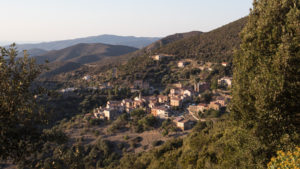
Quite a sad topic, so have a break and relax with this view of Corsica’s cutest village (Yes, that’s mine)
Indeed, with a relatively low rate of industrialization and agriculture, Corsican economy is largely based on tourism. I don’t think there’s another place on earth that could fit so many various landscapes in such a small area: wild bushy coast, long white-sand beaches, chestnut forests, alpine torrents, chilly glacial lakes atop cyclopean mountains and small secluded coves with crystal clear water… There’s literally something for everyone. But these landscapes, as numerous as they are, are fragile, and their preservation does not go in hand with modern touristic infrastructures and increased hosting capacities. The choice is difficult for the island, and if new constructions seem concentrated close to urbanized poles (drowning the small charming coastal towns under piles of concrete, but still preserving the wild coasts), but the temptation is huge to build on virgin spaces in order to boost tourism and enrich the population, even if it means making Corsica look like the Costa de Sol in August.
Quite a pickle Corsica’s in.
So now you are aware that Corsica is not just incredibly beautiful, she’s also diverse as hell. First, let’s put each micro-region specificity on the side and focus on the island’s intrinsic duality: its sea / mountain dichotomy.
One Island / Two facets
Unlike many Mediterranean coastlines, Corsican shores are particularly well preserved due to the mistrust of past generations towards the coast, where many invaders landed. It’s not a coincidence that the local specialties are based on pig meat rather than fish sausage (Corsican cape aside, but we’ll get to that).
The true Corsican soul therefore resides in the small hilltop villages with unpronounceable names, only reachable via roads that will make you taste your last meal again. This Corsica lives slowly, in peace, and represents in my opinion the best way to really apprehend the flair of the place. Sure, driving an hour to take a dip at the closest beach might seem relatively cumbersome, but inland Corsica offers magical hikes, lukewarm rivers with massaging waterfalls, phenomenal vantage points, and above all, a truly welcoming atmosphere. You will not pay ten euros for a bottle of Zilia at the village bar and you can really chat with the locals who will occasionally serve you their personal reserve of charcuterie with a complementary homemade shot. The accommodations are also cheaper there and you will really feel like you are a part of a greater whole, rather than being “Guest N ° 29836” staying in an overprice apartment with a view on the neighbour’s panties.
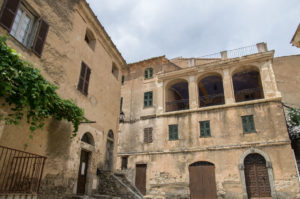
Just admit it, you’d be way more comfortable here rather than in 150-euros-a-night AirBnB rental overlooking Calvi’s supermarket parking lot
The Corsican coast is legitimately less intimate than its interior, but remains surprisingly preserved compared to its counterpart of southern France. As pointed above, the developed centers are largely concentrated in and around the coastal towns of Bastia, Île Rousse, Calvi, Ajaccio and Porto-Vecchio. Even if some more isolated places find themselves strangely urbanized over the years, most of the coastline remains wild enough not to have to chase your beach neighbors with umbrellas. Well.. at least in the north. Indeed, it would be fairer to speak of Corsican coastS. With geography and heterogeneous urbanization in the balance, almost every beach is different, as well as their occupation rate.
Bon, au vu de la taille de l’introduction, je ne vais pas rendre ce texte encore moins digeste en détaillant les micro-détails de chaque mini-terroir. MAIS je vais tâcher de décrire « succinctement » les grandes régions de l’île, à savoir le Cap-Corse, La Balagne, La Castagniccia, le centre et la cote sud, histoire que vous sachiez au moins à quoi vous attendre avant de débarquer dans ce refuge de sangliers.
Well, given the size of this introduction, I won’t make this text even less digest by detailing the micro-details of each mini-terroir. BUT I will try to describe “succinctly” the large regions of the island, so that you can at least be aware of what to expect before setting foot in this wild boar reserve.
TOURISTIC GUIDE
FYI : Most of the title here are clickable in order to give you a better idea of what (and where) I’m talking about
NORTH : The Corsican-Cape
An accusing finger pointed towards Genoa as the ancients like to remember, The Corsican-Cape is actually a miniature Corsica in Corsica, with unique landscapes and a particularly rich and adventurous historical culture. Although most of the villages remain hanging on their mountain (the Serra chain), many of them have a historic marina, the base port for the few Corsican fishermen. Remember, the Corsicans are mountain people more inclined to keep a herd of goats in the mountains than wading in a boat within arrows reach of the invaders. For the inhabitants of this region however, it would have been a shame not to take advantage of the benefits of the shore, surrounded by water as they were. It is therefore one of the only places on the island where you can stuff yourself with a good seafood platter.
From Bastia, the road goes north, traversing some not that charming seaside constructions, so you can skip Pietranera, Grigione and Miomo without missing much. Great first stop: Erbalunga. This splendid little marina nicknamed “The Painters’ Nest” is worth a stop with its awesome mini-streets, its half-demolished Genoese tower and its super-duper cute marina.
A little further north is the Sisco marina. Not a must-go in itself (built barely a century ago), but the small village of Sisco perched in the heights is well worth a little detour with its old houses shamelessly exposing their old stones.
From there, we enter a wilder part where marinas are rarer, the road twists and turns like a drunken Scotsman and discreet coves follow jagged rocks. The towns crossed are Pietracorbara and Cagnano, nice little spots with a marine flair.
The eastern coastal road ends in Maccinagio. It is possible to push a little further via a small dirt road which turns quickly into a path after Tamarone beach. A few more kilometers will take you to the Genoese tower of Sainte-Marie, one of the rare buildings of this type to literally have its feet in water. The “sentier des douaniers” continues to Barcaggio, the northernmost village of the island also accessible by car.
The switch to the cape western coast changes the landscape completely. No more cute little coves reachable by a charming path five minutes from the road, welcome to a world of very steep peaks surrounding sublime rocky beaches. The few villages on this coast are much more in altitude and offer incredible views, especially at sunset.
The descent continues slowly towards Saint-Florent, passing near the old asbestos mine of Canari. Not a very happy sight, but reaching it indicates that you are not far from the pretty beaches of Farinole and Saint-Florent, the local pocket-sized Saint-Tropez.
Saint-Florent
Accessible from Bastia in half hour via a wonderful road, the small town of Saint-Florent, founded by the Genoese in the 16th century, is built around a small citadel overlooking a marina that harbors more boats than people. This charming little town is indeed an ideal starting point to discover the wild beaches of the «Désert des Agriates », practically inaccessible by car. For those without a boat license and / or savings, a daily sea shuttle provides access to Lotu beach (pronounced Lodou) at a lower cost.
NORTH-WEST : The Balagne
The Balagne extends roughly from Calvi to Saint-Florent for the coastal part, and covers almost the entire interior from the northeast to Corte. Well, not exactly, but let’s pretend. For the purists, I voluntarily include the Nebbiu and Niolu regions in it.
Thanks to its great variety of landscapes as well as its wild side dotted with islets of civilization, this region is for me one of the most suitable for a day to day discovery of Corsica. This region does not necessarily avoid the summer “mass tourism”, particularly in Calvi, Île-Rousse and Saint-Florent, but it is far from massive and ugly concreting “à la” Porto-Vecchio or Ajaccio. In addition, it’s enough to move away a few kilometers inland to come across a string of small hilltop villages where life flows much more peacefully, nestled in their fresh altitude.
These villages, in fact, are mostly concentrated on roads coming from the sea, so the shoreline is never THAT far away. As for the real high-altitude villages of Asco, Castifao or Olmi-Capella, the proximity of mountain streams shaded by pine and alder forests offers a perfect alternative to crowded beaches.
I would therefore recommend a small village rental in the Île-Rousse region allowing you to spread day by day according to your desires of the moment. The main points of interest in this region are, in my opinion, the following :
The « désert des Agriates »
Do not expect to see a lot of cacti, the name of desert is a misnomer for a region that was once cultivated. Nowadays, the land has been reclaimed by the “maquis” after a steep decline in agricultural activity. The main road passes deep in the heights and all the beaches that surround its seafront are only accessible by boat, or by particularly rutted tracks. As mentioned above, the beaches of Lodu and Saleccia are accessible by sea-shuttles from Saint-Florent, but it is on foot that the real treasures of sand can be discovered. A day hike from Saleccia or Ostriconi beach will allow you to reach in a few short hours some real beach beauty, where only some cows and a few wasps might possibly bother you.
It is also possible to hike along the “sentier des douaniers” between Saint-Florent and Ostriconi, for a distance of about 23 km achievable in one or two days. It is preferable to hike it in the beginning / end of the summer season, otherwise the lack of shade and the summer heat might quickly turn you into beef jerky.
The beach of Ostriconi
The first (or last) beach of the Agriates desert, almost accessible by car! It will only cost you a short descent of one kilometer to enjoy its fine sand and its delicious “maquis” scents . This beach is really beautiful, although the sea can be dangerous offshore due to some currents. The best is to walk to the end of the beach where you will fine some small rocky coves with less algae. Try to arrive in the morning, it fills up quickly in high season.
The beach train – l’Île-Rousse / Calvi
La Micheline (that’s the Corsican nickname for that cute little train) makes several rotations a day between these two towns on a railway zig-zagging between the coast and the maquis. Many stops drop you off almost directly on the beaches, perfect plan to avoid parking problems. This trip is also ideal for a day in Calvi or Île-Rousse depending on your base camp location.
The artisans route
This mountain road starts at Lozari beach and takes you up into the hills, through a multitude of small hilltop villages allowing you to discover a new form of Corsican craftsmanship at each stage: blown glass in Feliceto, music boxes in Pigna, hug donkeys in San’Antonino, there is a little something for everyone.
The forest of Tartagine
Welcome to the deep Balagne! At the end of a never ending road (be advised, it’s a dead-end) you will discover the village of Olmi-Capella, dominating the Tartagine valley, bearing the name of the torrent which winds there. The walks in this area are simply magnificent, and allow you to cool off under the shade of the trees or in the water under wonderful old Genoese bridges.
The Asco canyon
A little further inland, near Ponte-Leccia, a small road winds lazily before taking off for a high-flying journey! Each bend becomes a gamble and it’s not easy to keep your eyes on the road as the landscape gets crazier and crazier, always overlooking the torrent below (where several stops are possible in order to laze on the rocks and / or wade in the natural pools). After a few kilometers, you’ll reach the small village of Asco, hanging on its vantage point. If you feel a little adventurous, continue for another fifteen kilometers to arrive at the ski resort, the starting point of a hike following the famous GR20 that will lead you to the Monte-Cinto (highest peak in Corsica). One of the best hike in Corsica, and maybe the steeper also.
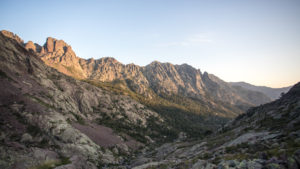
The hike leading to monte Cinto is as beautiful as it is knee-breaking. It’s not walking anymore, it’s Parkour.
SOUTH-WEST: From Calvi to Ajaccio
The west coast of Corsica, for the part between Calvi and Calcatoggio (a little above Ajaccio) is a small paradox : Magnificent with its wild beaches and vertiginous drop offs, the absence of a main road axis along this coast makes it strangely isolated. Thus, leaving Calvi by the south gives the impression of going off the beaten track, even if the landscape is only getting better. Weird ..
Although quite isolated, this part of the coast is perfect for finding a small rental in the nearby villages, or even closer to the sea without being overwhelmed by the crowd. If you get bored, why not take a look at these awesome little spots :
The Fango Valley
Just after Galeria, a small road goes up a valley, overlooking the Fango river, up to the village of Manso. A few kilometers further, the road stops at a place called Barghiana, where you will the start of several hikes leading to the nearby mountains, and sumptuous basins where the wate heats up in the sun, providing real temperate natural pools. Reachable in half an hour from the coast, this little piece of paradise has an excellent quality / time ratio.
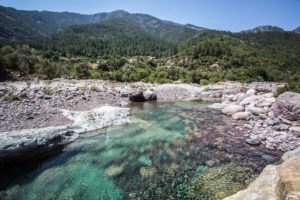
The famous Fango’s “swimming pools”. That’s the original picture by the way, no post-processing whatsoever
The Scandola reserve
This reserve covers both land and sea, and begins on a peninsula a little south of Galeria. Many companies offer sea excursions in the area in order to approach the superb rocky constructions, and allow you to admire the turquoise sea with the possibility of a little dip. The problem is that this increasingly intense tourist pressure is weakening the ecosystem, and even if sustainable tourism options are being studied, it’s not completely there yet.
A more respectful approach is walking via a small maquisarde hike to Girolata, a pocket village accessible only by boat or on foot whose gulf offers superb beaches and pristine reefs. As long as you stay on the trails, you can enjoy the area without having too much of a bad conscience.
Porto and the « Calanches » of Piana
The Calanches of Piana are a set of pink granite peaks forming stone cathedrals, overlooking the road and the coast before plunging into the sea, creating stone bridges in the process. Absolutely stunning! Bonus point at sunset where the orange color of the sky mixes with the sparkling pink of the rocks, offering an inexpensive acid trip. No kidding, I think this part of the coast is the most beautiful in Corsica. To make the most of it, why not stop off in Porto: A small marina offering a back-breaking pebble beach, but also some welcoming inexpensive campsites, diving clubs, a restored Genoese tower , boat trips to see the rocks up close… In short, an ideal stopover to enjoy the area for a couple of days.
From Cargese to Ajaccio
A little further south, the large coastal village of Cargese is also an ideal base camp for enjoying the large southern sandy beaches such as Liamone for example. The whole region looks like the French Riviera with its coastal roads directly leading to easily accessible beaches with turquoise waters. Nevertheless, we are moving away from the Corsican image of an isolated coastline, but the area retains its charm, especially in the beginning and end of the summer season.
SOUTH: From Ajaccio to Porto-Vecchio.
I admit that this part of Corsica is less familiar to me. Not that it’s THAT ugly, but I’m a kid from the north. Raised in the gentle sea breeze of Haute-Corse, far from those « Ajacciens » who speak weird and name all their streets Napoleon. Pretty original guys, keep it up !
Well, for real, southern of Corsica is magnificent, and the Haute-Corse / Corse du Sud rivalry never goes beyond innocent teasing. However, you should know that yes, the south is more touristic than the north. The good sides are more hotel infrastructures and a more developed tourism, and the bad are a greater affluence, as well as a slightly less preserved coast.
The interior there however seems to me a bit wilder than the center of Corsica, thanks to a less developed road network around. The lack of high mountains also limits the opportunities for extreme sports. Nevertheless, if you are looking for the peace and quiet of a truly unspoiled region, the southern interior is quite suitable.
For lack of in-depth knowledge, my recommendations on this coast will therefore be limited to the most famous spots.
Ajaccio
Downtown Ajaccio is not devoid of charm, and you can still feel a special atmosphere while strolling through the small streets connecting the Cours Napoléon. The citadel separates the city in two between the port to the north, the small beaches to the south and the central market not far away offering excellent local products. The « route des Sanguinaires » is still magnificent, and a sunset on these islands is a sight to behold.
However, I won’t recommend spending more than two days in the city. Like many “big” Corsican towns, the traffic in summer is horrible, thanks to insane urbanization and undersized roads. Moreover, while the center is charming, the entrance to the city is quite ugly with hideous constructions surrounding depressing shopping areas that stretch for miles. The surrounding beaches can be nice, but are packed in summer, and traffic jams / parking problems are the cherry on the crap-cake.
In short, flee as soon as you can, at least as far as Sartene while avoiding Propriano (a mini-Ajaccio without the charm of the old town), possibly stopping for a little splash at Cupabia beach, or at the prehistoric site of Filitosa which is definitely worth a look.
From Sartene to Bonifacio
Sartene is a very large moutain village with a rich history, which can serve as an excellent base camp for exploring the surroundings. One of the most Corsican of Corsican towns, the atmosphere here remains deeply authentic. One of the local curiosities is the Catenacciu, a procession taking place in April where an unknown « penitent » dressed in red walks for two kilometers while carrying a 35kg cross and a 14kg steal chain … Traditions, traditions.
The beaches a little further south are awesome but the access can be a tad difficult (Tizzano, the silver beach). Special prize for the Roccapina beach where stands the famous “lion”, a rock formation vaguely reminiscent of a big cat.
The coastal road will swiftly take you to Bonifacio, a touristic and geological curiosity: the old town is built on one of the only limestone cliffs of the island. This town / village, although very busy in summer, is a splendor with its small labyrinthine streets and its panorama that can even show the nearby Sardinia. Don’t miss the King of Aragon’s Staircase: A flight of steps carved out of the rock that goes down the cliff side to the sea. It isn’t free, but it’s fun.
For leasure, the beaches of Sperone are nice, although very busy. A boat trip through the limestone caves is also worth a detour. Nevertheless, the icing on the figatelli remains spending the day on the Lavezzi Islands, a tiny archipelago a little south of Bonifacio only reachable by boat (prefer the first shuttle to be the first on the spot). If the island of Cavallo is a wealthy-people geto , the island of Retino is devoid of any construction. Nothing better than finding a beach there on the first rotation and spend the day roasting in the sun while diving from time to time in the crystal clear waters stuffed with aquatic life.
From Bonifacio to Porto-Vecchio
This part of the coast is certainly home to the most beautiful beaches in Corsica, namely La Rondinara, Santa-Giulia and Palombagia. This triptych combines soft white sand, truly tropical waters and a few rocks ideal for a little snorkeling in pool temperature waters. The only problem is that being located near Porto-Vecchio, attendance can reach the breaking point in the middle of the season. It’s best to go there early in the morning or for a late evening picnic.
The interior here is immediately more pleasant with the « Bavella needles » a superb mountain range offering torrents, hikes and crazy views, especially at sunset and sunrise.
EAST: The eastern plain
No.
CENTRAL CORSICA
For this part it’s quite simple. Take a map of the island and a compass, point to Corte for a radius of fifteen kilometers, draw a circle as we did in middle school, and BAM! Everything inside this circle is beautiful and you MUST try it.
Well, let’s still try to be a bit more precise.
Corte and its surroundings
Corte was the official capital of the island during its very short independence in the 18th century, and as such, fully embodies the historical and cultural soul of Corsica. Do not hesitate to take a tour at the Corsican history museum located in the citadel to get a more precise idea.
Hot in summer, cold in winter, far from the sea but with privileged access to the island’s highest peaks, Corte is an ideal starting point for anyone more interested in a proper hike than lazing in the sun on the hot sand. Nevertheless, there are many opportunities to soak your calves in the surrounding torrents.
As such, I can only advise the traveler in search of authenticity and steep but sumptuous hikes to stop in the area for a few days. The mountain excursions of the day will be soothed in the evening in a small typical restaurant, where the veal with olive and the living cheese will slowly be digested to the sweet sound of polyphonies escaping from a nearby bar.
But wich hikes will you ask? « ALL OF THEM » I would answer. But for a small sample :
The Restonica valley opens to the south-west of Corte, where a small road will take you to the sheepfolds of Grotelle (Chez Francè). You can leave your coach in the small adjacent car park and start a walk that will take you to the Melo and Capitello lakes, from where you can admire splendid glacial valleys while taking a small part of the GR20. It rises sharply, but it’s the jam.
Another splendid hike will take you directly from Corte to the Sega refuge via the Tavignano valley. The round trip is nice in itself, but one night at the refuge will allow you to push the next day to the Nino Lake: a splendid high-altitude lake surrounded by grass and the famous pozzines – like small ponds in peaty terrain – unique landscape in Corsica.
While driving from Corte to the Col of Vergio, it is also possible to park your car there and walk part of the GR20 northwards, practically to the source of Golo (another river). Tucked into an isolated valley, you will find splendid basins hollowed out by the torrent, with massaging waterfalls as a bonus. The steepness is not so bad over the 15km of this walk.
There are far too many hikes in the area for me to list them all. Do not hesitate to take a look at the “VisioRando” website in this area. The possibilities are almost endless.
In conclusion, the center of Corsica and the surroundings of Corte in particular will satisfy all your your mountaineering desires. For more details about the interior, do not hesitate to take a look at my article on the GR20 – North (Soon to be published. Teasiiiing) which goes more in details about the Corsican interior.
The Castagniccia
No tour of Corsica would be complete without at least a mention of Castagniccia, a very special region, stuck between sea and mountain. Beginning east of the northern mountains and ending in the heights of the eastern plain, the story of this little corner would almost be worth a full article. But to sum up, let’s say that if the Corsican soul had to reside somewhere, it would surely have taken up residence up there.
Native region of Pascal Paoli (Remember? the local founding father !), It has specialized over the centuries in the cultivation of chestnut trees, whose beautiful and long branches still shade the small wandering roads. Roads winding between lost villages and abandoned churches where each fountain, each canopy, each scent of the maquis paint a picture of extreme tranquility, discreet pride and gentle harshness.
This chestnut culture not only saved the island from famine on several occasions, but also gave a very special identity to the villages and inhabitants in the area.
So don’t hesitate to spend a few days along these long calm roads, traversing dense and silent forests, small sleepy villages, many springs (including Orezza, the local sparkling water), to end up having a drink in Cervione after cooling off at the Ucelluline waterfall . You won’t regret it.
EPILOGUE
Thus ends our little tour. Fragmentary, personal, I hope this text allowed you to, at least, underline certain corners which are close to my heart while, perhaps, making you want to discover the many other treasures that this crazy island has to offer.
That said, I cannot guarantee that your future trip will be perfect. Corsica is expensive, it’s a fact, and spending family vacations there is becoming a luxury that is increasingly difficult to afford. Accommodation in the heights is certainly cheaper, but the transport budget remains incompressible. The Corsicans are numerous: Most have their hearts on their hands, others sometimes knowingly maintain stereotypes (without being too rude), a minority finally, rarer, just loves to be a dick, let’s not hide it.
However, never take the possible initial harshness as meanness, restraint as misplaced pride, or outspokenness as provocation. Corsica and the Corsicans had a hard time in the past, which gave birth to this weird alloy of pride of the land mixed with a diffuse fear of the slow disappearance of a fragile cultural heritage. Thus, the inhabitants and their island are a mirror of each other: The best discoveries are sometimes made at the cost of some effort, but I promise you that the reward is 1000 times worth the initial investment.
